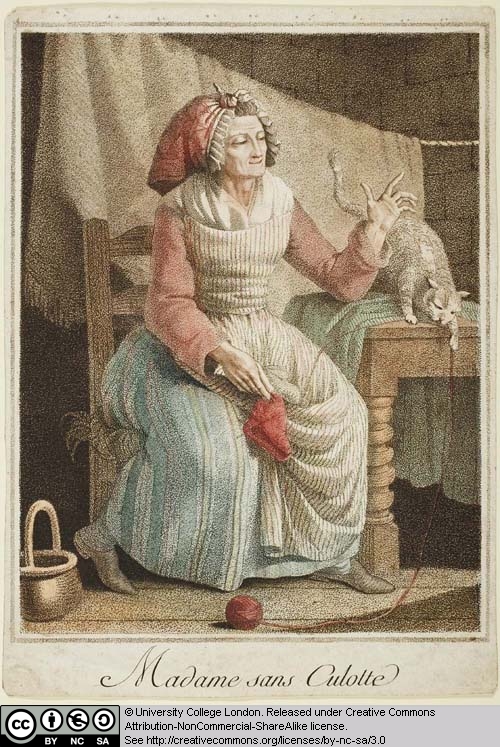5 Madame Sans Culottes

Madame sans Culotte, c.1791
– 1794
Stipple engraving with
hand-colouring
Publisher unrecorded
This engraving presents the viewer with a warm and
sympathetic representation of an elderly (but in no sense decrepit) sans-culotte who
is depicted reacting with quiet amusement to the games of a playful cat who
toys with her ball of wool, forcing her to momentarily suspend her knitting. It
is a homely and seemingly natural scene, but one nonetheless loaded with
information that helps us reconstruct the politics and character of Madame sans
Culotte. Her generic name and the fact that she is dressed in the colours of the
tricolour identify her as an allegorical figure rather than an individual
and she embodies the archetypal traits of the patriotic revolutionary woman.
The scene is set in a poor but respectable home that shows
the evidence of her domestic labour: behind her hangs a washed sheet put out to
dry. Yet as well as being a dutiful housewife, she is constructed as an
exemplary patriot and for instance, we see her knitting a liberty bonnet ,
perhaps for use by her husband or son. Interestingly, she does not wear the cap
but a red scarf that mimics its appearance. This can be explained by the fact
that the wearing of the liberty bonnet by women was widely regarded as improper
and even, (somewhat paradoxically), counter-revolutionary.
[1] Madame sans Culotte then, does not overstep this boundary but works within
it.
The cat is also a significant inclusion. In addition to its
role in the domestic narrative it also functions as the allegorical attribute
of Madame sans Culotte , as well as serving as a narrative tool. Traditionally
a symbol of liberty, the cat may be intended to convey the idea that although Madame
has the freedom to come and go, she chooses to conduct her patriotic and
domestic duties from home. At a time when worries were being expressed about
the consequences of women’s new-found independence – the home deserted,
children abandoned – this would have been readily interpreted as a sign of her
virtue.
The quality of the print suggests that it was intended for
an audience belonging to a higher financial bracket than Madame herself, and
that it would have had a relatively limited distribution. A companion piece
depicting her male counterpart Le Bon sans Culotte was also available from the
same engraver.
[1] See Dominique Godineau, The Women
of Paris and their French Revolution, trans Katheine Streip,
Licensed under the Creative Commons Attribution Non-commercial Share Alike 3.0 License
This resource has been released as an open educational resource (OER) on a Creative Commons 'Attribution Non-commercial Share Alike' license. This means that once downloaded, content can be modified and improved to complement a particular course. This requires, however, that improvements are recycled back into the OER community. All content present at the time of download must be accordingly credited and, in turn, novel content must be appropriately licensed.